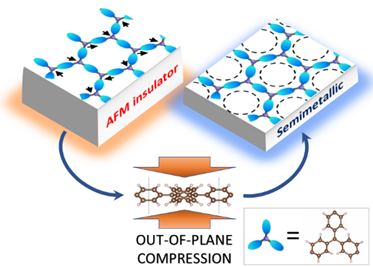Radical 2D Materials Respond under Pressure
A recent predictive computational study published in Advanced Functional Materials involving a collaboration between three IQTC research groups has established a new class of tunable 2D correlated electron materials. The work was also awarded the distinction of being a Very Important Paper (VIP) (a designation that is given to 5% of articles) by the reviewers and editors of the journal.
2D Hexagonal Covalent Organic Radical Frameworks as Tunable Correlated Electron Systems, Raul Santiago, Isaac Alcón, Jordi Ribas‐Arino, Mercè Deumal, Ibério de P. R. Moreira, Stefan T. Bromley*, Advanced Functional Materials 31, 2004584 (doi.org/10.1002/adfm.202004584)
Graphene is a hexagonally ordered 2D material of three-fold connected sp2 carbon sites which form a persistent gapless semimetallic state. The lack of a gap in this single layer material greatly hinders its use in electronic devices. The ability to tune the electron-electron coupling of such materials promises access to correlated gapped electronic states for opening the door to new applications.

This study investigates 2D hexagonal covalent organic frameworks based on stable radical molecules (2D hex-CORFS), where each radical node contributes a single unpaired electron. The researchers have found that these 2D hex-CORFs can be tuned between a strongly correlated antiferromagnetic Mott insulator state and a semimetallic state by modest experimentally accessible out-of-plane compression.
The Mott metal–insulator transition on half‐filled (i.e. single electron per node) lattices is an archetypal demonstration of how quantum states in a material can be driven by electronic correlation. The properties of quantum materials hold huge technological promise but challenge this fundamental understanding of complex electronic interactions in solids. Recent experiments on twisted bilayers of 2D materials provide an experimentally accessible means to probe such transitions, but these seemingly simple systems belie high complexity due to the myriad of possible interactions. In contrast, the study shows that electron correlation can be simply tuned in experimentally viable 2D hex‐CORFs and thus establish them as a class of versatile single‐layer quantum materials to advance the understanding of low dimensional correlated electronic systems.
[1] VIP designation is only awarded to approx. 5% of articles
